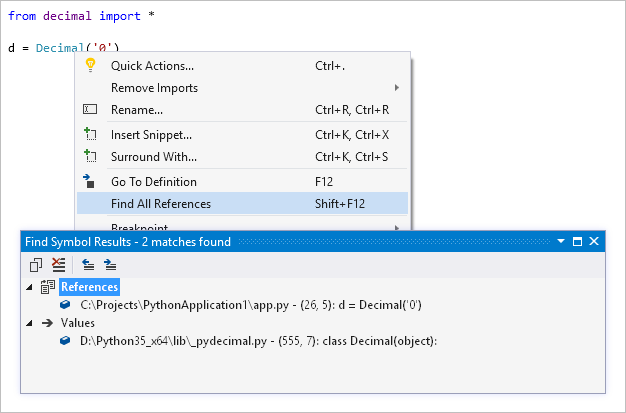Edit Python code
Applies to: ![]() Visual Studio
Visual Studio ![]() Visual Studio for Mac
Visual Studio for Mac
Note
This article applies to Visual Studio 2017. If you're looking for the latest Visual Studio documentation, see Visual Studio documentation. We recommend upgrading to the latest version of Visual Studio. Download it here
Because you spend much of your development time in the code editor, Python support in Visual Studio provides functionality to help you be more productive. Features include IntelliSense syntax highlighting, autocompletion, signature help, method overrides, search, and navigation.
The editor is also integrated with the Interactive window in Visual Studio, making it easy to exchange code between the two. See Tutorial Step 3: Use the Interactive REPL window and Use the Interactive window - Send to Interactive command for details.
For general documentation on editing code in Visual Studio, see Features of the code editor. Also see Outlining, which helps you stay focused on particular sections of your code.
You can also use the Visual Studio Object Browser (View > Other Windows > Object Browser or Ctrl+W > J) for inspecting Python classes defined in each module and the functions defined in those classes.
IntelliSense
IntelliSense provides completions, signature help, quick info, and code coloring. Visual Studio 2017 versions 15.7 and later also support type hints.
To improve performance, IntelliSense in Visual Studio 2017 version 15.5 and earlier depends on a completion database that's generated for each Python environment in your project. Databases may need refreshing if you add, remove, or update packages. Database status is shown in the Python Environments window (a sibling of Solution Explorer) on the IntelliSense tab (see Environments window reference).
Visual Studio 2017 version 15.6 and later uses a different means to provide IntelliSense completions that aren't dependent on the database.
Completions
Completions appear as statements, identifiers, and other words that may be appropriately entered at the current location in the editor. What's shown in the list is based on context and is filtered to omit incorrect or distracting options. Completions are often triggered by typing different statements (such as import) and operators (including a period), but you can have them appear at anytime by typing Ctrl+J > Space.

When a completion list is open, you can search for the completion you want using the arrow keys, the mouse, or by continuing to type. As you type more letters, the list is further filtered to show likely completions. You can also use shortcuts such as:
- Typing letters that are not at the start of the name, such as 'parse' to find 'argparse'
- Typing only letters that are at the start of words, such as 'abc' to find 'AbstractBaseClass' or 'air' to find 'as_integer_ratio'
- Skipping letters, such as 'b64' to find 'base64'
Some examples:

Member completions appear automatically when you type a period after a variable or value, along with the methods and attributes of the potential types. If a variable could be more than one type, the list includes all possibilities from all types, with extra information to indicate which types support each completion. Where a completion is supported by all possible types, it is shown without annotation.

By default, "dunder" members (members beginning and ending with a double underscore) are not shown. In general, such members should not be accessed directly. If you need one, however, typing the leading double underscore adds these completions to the list:
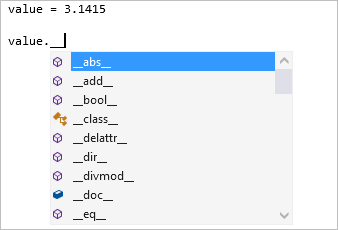
The import and from ... import statements display a list of modules that can be imported. With from ... import, the list includes members that can be imported from the specified module.

The raise and except statements display lists of classes likely to be error types. The list may not include all user-defined exceptions, but helps you find suitable built-in exceptions quickly:
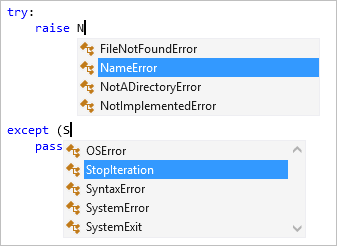
Typing @ starts a decorator and shows potential decorators. Many of these items aren't usable as decorators; check the library documentation to determine which to use.

Tip
You can configure the behavior of completions through Tools > Options > Text Editor > Python > Advanced. Among these, Filter list based on search string applies filtering of completion suggestions as you type (default is checked), and Member completion displays intersection of members shows only completions that are supported by all possible types (default is unchecked). See Options - completion results.
Type hints
Visual Studio 2017 version 15.7 and later.
"Type hints" in Python 3.5+ (PEP 484 (python.org) is an annotation syntax for functions and classes that indicate the types of arguments, return values, and class attributes. IntelliSense displays type hints when you hover over functions calls, arguments, and variables that have those annotations.
In the example below, the Vector class is declared as List[float], and the scale function contains type hints for both its arguments and return value. Hovering over a call to that function shows the type hints:

In the following example, you can see how the annotated attributes of the Employee class appear in the IntelliSense completion popup for an attribute:

It's also helpful to validate type hints throughout your project, because errors won't normally appear until run time. For this purpose, Visual Studio integrates the industry standard MyPy tool through the context menu command Python > Run Mypy in Solution Explorer:

Running the command prompts you to install the mypy package, if needed. Visual Studio then runs mypy to validate type hints in every Python file in the project. Errors appear in the Visual Studio Error List window. Selecting an item in the window navigates to the appropriate line in your code.
As a simple example, the following function definition contains a type hint to indicate that the input argument is type str, whereas the call to that function attempts to pass an integer:
def commas_to_colons(input: str):
items = input.split(',')
items = [x.strip() for x in items]
return ':'.join(items)
commas_to_colons(1)
Using the Run Mypy command on this code generates the following error:

Tip
For versions of Python before 3.5, Visual Studio also displays type hints that you supply through Typeshed stub files (.pyi). You can use stub files whenever you don't want to include type hints directly in your code, or when you want to create type hints for a library that doesn't use them directly. For more information, see Create stubs for Python modules in the mypy project wiki.
At present, Visual Studio doesn't support type hints in comments.
Signature help
When writing code that calls a function, signature help appears when you type the opening ( and displays available documentation and parameter information. You can also make it appear with Ctrl+Shift+Space inside a function call. The information displayed depends on the documentation strings in the function's source code, but includes any default values.
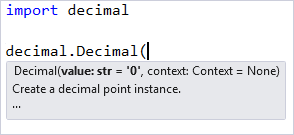
Tip
To disable signature help, go to Tools > Options > Text Editor > Python > General and clear Statement completion > Parameter information.
Quick info
Hovering the mouse pointer over an identifier displays a Quick Info tooltip. Depending on the identifier, Quick Info may display the potential values or types, any available documentation, return types, and definition locations:
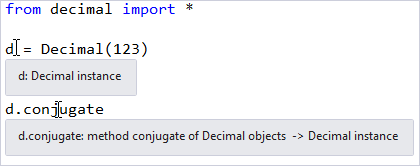
Code coloring
Code coloring uses information from code analysis to color variables, statements, and other parts of your code. For example, variables that refer to modules or classes may be shown in a different color than functions or other values, and parameter names appear in a different color than local or global variables. (By default, functions aren't shown in bold):

To customize the colors, go to Tools > Options > Environment > Fonts and Colors and modify the Python entries in the Display items list:

Tip
To disable code coloring, go to Tools > Options > Text Editor > Python > Advanced and clear Miscellaneous Options > Color names based on type. See Options - Miscellaneous options.
Code snippets
Code snippets are fragments of code that can be inserted into your files by typing a shortcut and pressing Tab, or using the Edit > IntelliSense > Insert Code Snippet and Surround With commands, selecting Python, then selecting the desired snippet.
For example, class is a shortcut for a code snippet that inserts a class definition. You see the snippet appear in the autocompletion list when you type class:

Pressing Tab generates the rest of the class. You can then type over the name and bases list, moving between the highlighted fields with Tab, then press Enter to begin typing the body.

Menu commands
When you use the Edit > IntelliSense > Insert Code Snippet menu command, you first select Python, then select a snippet:
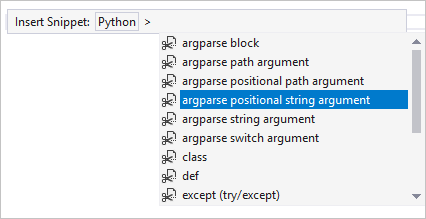
The Edit > IntelliSense > Surround With command, similarly, places the current selection in the text editor inside a chosen structural element. For example, suppose you had a bit of code like the following:
sum = 0
for x in range(1, 100):
sum = sum + x
Selecting this code and choosing the Surround With command displays a list of available snippets. Choosing def from the list places the selected code within a function definition, and you can use the Tab key to navigate between the highlighted function name and arguments:

Examine available snippets
You can see the available code snippets in the Code Snippets Manager, opened by using Tools > Code Snippets Manager menu command and selecting Python as the language:
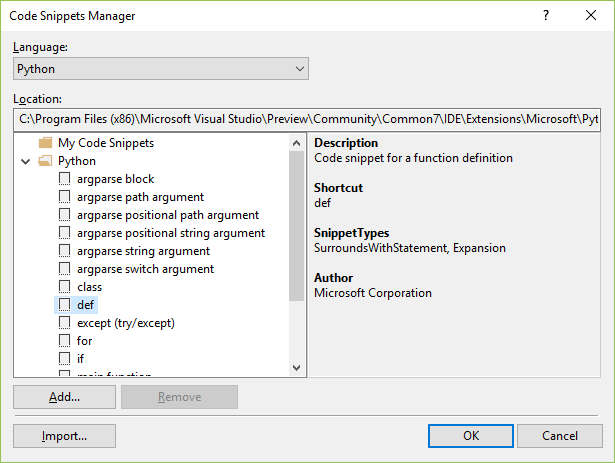
To create your own snippets, see Walkthrough: Create a code snippet.
If you write a great code snippet that you'd like to share, feel free to post it in a gist and let us know. We may be able to include it in a future release of Visual Studio.
Navigate your code
Python support in Visual Studio provides several means to quickly navigate within your code, including libraries for which source code is available: the navigation bar, Go To Definition, Navigate To, and Find All References. You can also use the Visual Studio Object Browser.
Navigation bar
The navigation bar is displayed at the top of each editor window and includes a two-level list of definitions. The left drop-down contains top-level class and function definitions in the current file; the right drop-down displays a list of definitions within the scope shown in the left. As you move around in the editor, the lists update to show your current context, and you can also select an entry from these lists to jump directly to.
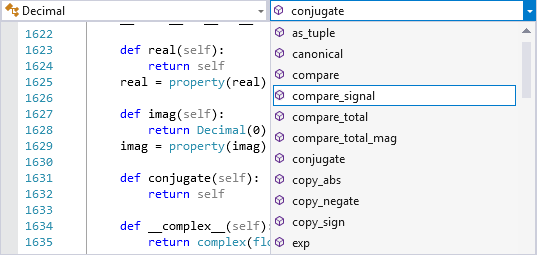
Tip
To hide the navigation bar, go to Tools > Options > Text Editor > Python > General and clear Settings > Navigation bar.
Go To Definition
Go To Definition quickly jumps from the use of an identifier (such as a function name, class, or variable), to the source code where it's defined. You invoke it by right-clicking an identifier and selecting Go To Definition or, by placing the caret in the identifier and pressing F12. It works across your code and external libraries provided that source code is available. If library source code is not available, Go To Definition jumps to the relevant import statement for a module reference, or displays an error.
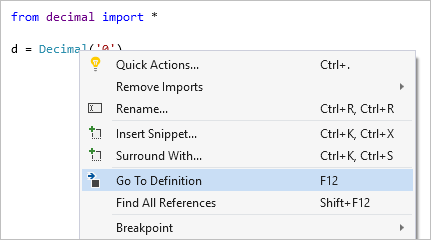
Navigate To
The Edit > Navigate To command (Ctrl+,) displays a search box in the editor where you can type any string and see possible matches in your code that defines a function, class, or variable containing that string. This feature provides a similar capability as Go To Definition but without having to locate a use of an identifier.
Double-clicking any name, or selecting with arrow keys and Enter, navigates to the definition of that identifier.
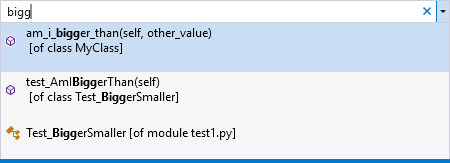
Find All References
Find All References is a helpful way of discovering where any given identifier is both defined and used, including imports and assignments. You invoke it by right-clicking an identifier and selecting Find All References, or by placing the caret in the identifier and pressing Shift+F12. Double-clicking an item in the list navigates to its location.
